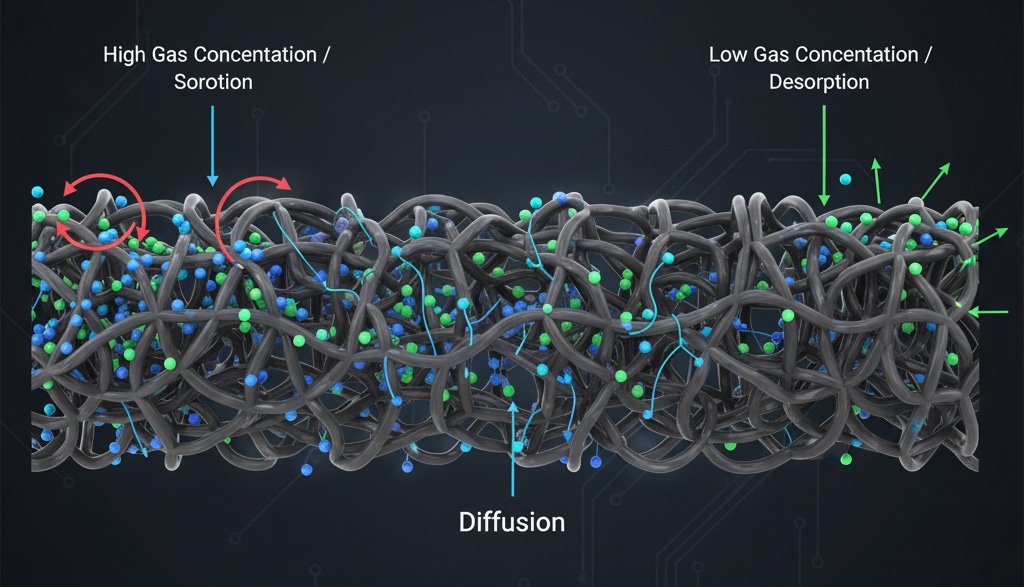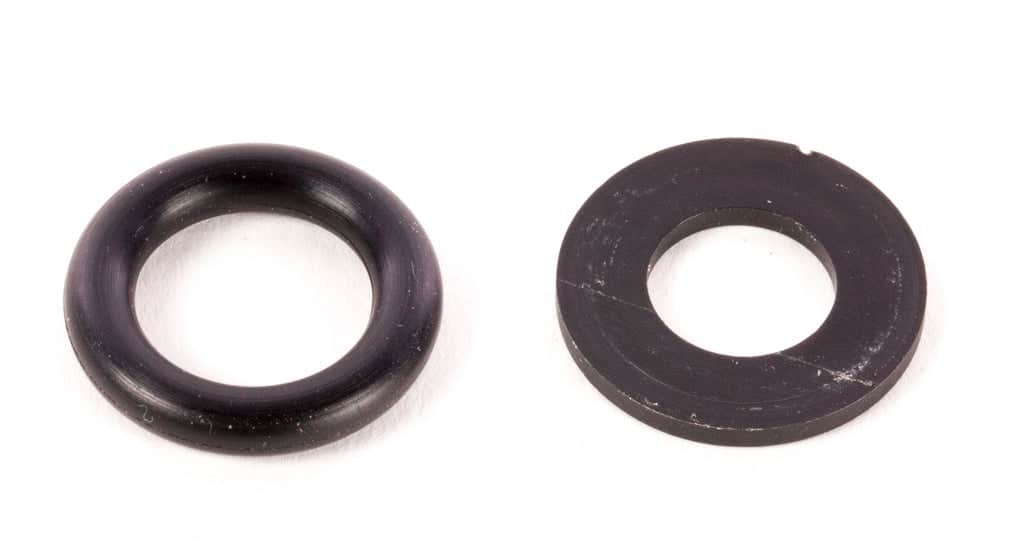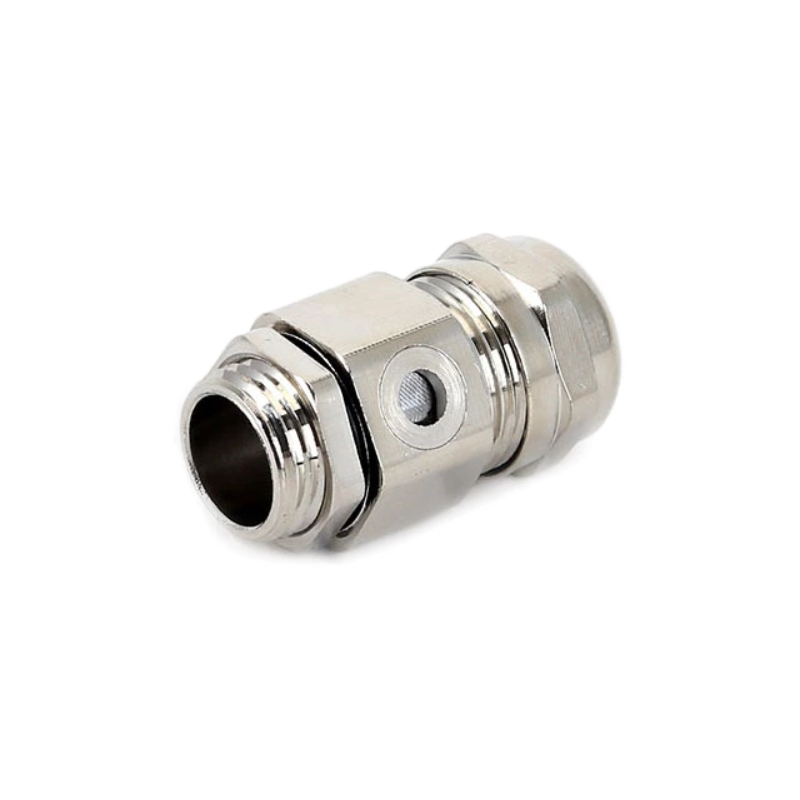Introduction
Think your cable gland seals are completely gas-tight? Think again. 🤔 Even the best sealing materials allow some level of gas and vapor permeation, and understanding this phenomenon is crucial for applications where even minute leakage can spell disaster. From explosive atmospheres in petrochemical plants to sensitive electronic enclosures, the permeability characteristics of gland seals directly impact system safety and performance.
The permeability1 of gland seals to gases and vapors refers to the rate at which gas molecules penetrate through sealing materials at the molecular level, measured in specific units that quantify mass transfer per unit area, thickness, time, and pressure differential. This property is fundamentally different from gross leakage through mechanical gaps and requires specialized testing methods and material selection strategies.
Just last month, Marcus from a semiconductor facility in Munich contacted us after discovering that their “hermetically sealed” control panels were experiencing moisture-related failures. The culprit? Vapor permeation through standard rubber seals that nobody had considered during the design phase. This kind of oversight can cost millions in downtime and equipment damage, which is why understanding seal permeability has become essential for engineers specifying cable glands in critical applications.
Table of Contents
- What Is Gas and Vapor Permeability in Cable Gland Seals?
- How Do Different Sealing Materials Compare for Permeability?
- What Factors Influence Seal Permeability Performance?
- How Is Permeability Testing Conducted for Cable Glands?
- What Are the Critical Applications Requiring Low Permeability Seals?
- Conclusion
- FAQs About Cable Gland Seal Permeability
What Is Gas and Vapor Permeability in Cable Gland Seals?
Gas and vapor permeability in cable gland seals is the molecular-level transport of gas molecules through the bulk material of sealing elements, governed by the solution-diffusion mechanism2 where gases dissolve into the seal material and diffuse through its molecular structure.

The Science Behind Molecular Permeation
Unlike mechanical leakage through visible gaps or defects, permeability occurs at the molecular level through the polymer matrix of sealing materials. The process involves three distinct steps:
- Sorption: Gas molecules dissolve into the seal material surface
- Diffusion: Dissolved molecules migrate through the polymer matrix
- Desorption: Molecules emerge from the opposite surface
The permeability coefficient (P) combines both solubility and diffusion effects, typically expressed in units of cm³(STP)·cm/(cm²·s·cmHg) or similar dimensional analysis units.
Permeability vs. Permeation Rate
It’s crucial to distinguish between these related but different concepts:
- Permeability: Material property independent of geometry
- Permeation Rate: Actual gas flow through a specific seal configuration
At Bepto, we’ve developed specialized testing protocols to measure both parameters for our cable gland seals, ensuring our customers receive comprehensive permeation data for their specific applications.
Common Gases and Their Permeation Characteristics
Different gases exhibit vastly different permeation rates through identical sealing materials:
| Gas Type | Relative Permeability | Critical Applications |
|---|---|---|
| Hydrogen | Very High (100x) | Fuel cell systems, refineries |
| Helium | High (50x) | Leak testing, cryogenic systems |
| Water Vapor | Variable (depends on humidity) | Electronics, food processing |
| Oxygen | Medium (5x) | Pharmaceutical, food packaging |
| Nitrogen | Low (1x baseline) | Inert atmosphere systems |
| Carbon Dioxide | Medium (3x) | Beverage industry, greenhouses |
Hassan, who manages a hydrogen production facility in Abu Dhabi, learned this lesson the hard way when standard EPDM seals in his cable glands allowed significant hydrogen permeation, creating safety concerns. We worked together to specify fluorocarbon seals that reduced hydrogen permeation by over 90%, ensuring his facility met strict safety standards.
How Do Different Sealing Materials Compare for Permeability?
Different sealing materials exhibit dramatically varying permeability characteristics, with fluorocarbon elastomers typically providing the lowest gas permeation rates, followed by nitrile rubber, while silicone and natural rubber generally show the highest permeability to most gases.

Material Performance Rankings
Based on our extensive testing at Bepto’s materials laboratory, here’s how common cable gland sealing materials rank for gas barrier properties:
Excellent Barrier Performance (Low Permeability):
- Fluorocarbon (FKM/Viton)3: Outstanding chemical resistance and low permeability
- Chloroprene (CR/Neoprene): Good general-purpose barrier properties
- Nitrile (NBR): Excellent for hydrocarbon resistance with moderate permeability
Moderate Barrier Performance:
- EPDM: Good ozone resistance but higher gas permeability
- Polyurethane: Variable performance depending on formulation
Poor Barrier Performance (High Permeability):
- Silicone: Excellent temperature range but high gas permeability
- Natural Rubber: Good mechanical properties but poor gas barrier
Temperature Effects on Material Performance
Permeability increases exponentially with temperature for most elastomers. Our testing shows:
- 25°C to 75°C: 3-5x increase in permeability for most materials
- 75°C to 125°C: Additional 2-3x increase
- Above 150°C: Dramatic increases, material-dependent
Chemical Compatibility Considerations
The best barrier material is useless if it’s not chemically compatible with the application environment. We’ve seen cases where engineers selected low-permeability materials that failed due to chemical attack, ultimately providing worse performance than higher-permeability but chemically resistant alternatives.
What Factors Influence Seal Permeability Performance?
Seal permeability performance is influenced by temperature, pressure differential, seal geometry, material thickness, aging effects, and the specific molecular size and solubility of the permeating gas or vapor.
Primary Influencing Factors
Temperature Impact:
Temperature is the most significant factor affecting permeability. Higher temperatures increase molecular motion and polymer chain mobility, creating larger free volume for gas diffusion. Our data shows permeability roughly doubles for every 10°C temperature increase in most elastomers.
Pressure Differential:
While permeation rate increases linearly with pressure differential for most gases, some materials exhibit non-linear behavior at high pressures due to plasticization effects or structural changes in the polymer matrix.
Seal Geometry and Thickness:
Permeation rate is inversely proportional to seal thickness. Doubling the seal thickness halves the permeation rate, making this a critical design parameter for low-permeability applications.
Secondary Factors
Aging and Environmental Exposure:
UV exposure, ozone, and chemical contact can alter polymer structure, typically increasing permeability over time. We recommend periodic permeability testing for critical applications to monitor seal degradation.
Compression and Stress State:
Mechanical compression can reduce permeability by decreasing free volume in the polymer matrix, but excessive compression may cause stress cracking that increases permeation through mechanical pathways.
Humidity and Moisture Content:
Water vapor can plasticize many elastomers, increasing permeability to other gases. This is particularly important in outdoor applications or high-humidity environments.
Real-World Application Example
Marcus from the Munich semiconductor facility I mentioned earlier discovered that their moisture problems weren’t just about water vapor permeation. The humidity was also increasing the permeability of their seals to other contaminant gases, creating a cascading effect that compromised their clean room environment. We solved this by specifying fluorocarbon seals with integrated desiccant chambers in their cable gland assemblies.
How Is Permeability Testing Conducted for Cable Glands?
Permeability testing for cable glands is conducted using standardized methods such as ASTM D14344 or ISO 2556, which measure the steady-state transmission rate of specific gases through seal materials under controlled temperature, pressure, and humidity conditions.
Standard Test Methods
ASTM D1434 – Standard Test Method for Determining Gas Permeability:
This method uses a manometric technique where gas pressure buildup is measured on the low-pressure side of a test specimen. The test provides permeability coefficients in standard units and is widely accepted for engineering calculations.
ISO 2556 – Plastics – Determination of the Gas Transmission Rate:
Similar to ASTM D1434 but with slightly different specimen preparation and calculation methods. This standard is more commonly used in European markets.
ASTM F1249 – Water Vapor Transmission Rate:
Specifically designed for water vapor permeability testing, this method is crucial for applications where moisture ingress is a primary concern.
Our Testing Capabilities at Bepto
We’ve invested in state-of-the-art permeability testing equipment that allows us to:
- Test at temperatures from -40°C to +200°C
- Evaluate pressure differentials up to 10 bar
- Measure permeability for over 20 different gases and vapors
- Conduct accelerated aging studies to predict long-term performance
Test Specimen Preparation
Proper specimen preparation is critical for accurate results:
- Material conditioning: 24-hour equilibration at test conditions
- Thickness measurement: Multiple points to ensure uniformity
- Surface preparation: Clean, defect-free surfaces
- Mounting: Proper sealing to prevent edge effects
Data Interpretation and Reporting
Test results must be properly normalized and reported with appropriate units. We provide our customers with comprehensive reports including:
- Permeability coefficients for specific gases
- Temperature dependence data
- Comparison with industry benchmarks
- Recommendations for application-specific requirements
What Are the Critical Applications Requiring Low Permeability Seals?
Critical applications requiring low permeability seals include hazardous area installations, pharmaceutical clean rooms, semiconductor manufacturing, food processing under modified atmospheres, and any application where trace gas contamination can compromise safety or product quality.
Explosion-Proof and Hazardous Area Applications
In explosive atmospheres, even minute amounts of flammable gas permeation can create safety hazards. Our explosion-proof cable glands use specialized fluorocarbon seals that maintain permeation rates below critical thresholds even after years of service.
Key Requirements:
- Hydrogen permeation < 10⁻⁸ cm³/s for most applications
- Long-term stability in harsh chemical environments
- Compliance with ATEX, IECEx, and NEC standards
Pharmaceutical and Biotechnology
Clean room environments require maintaining specific atmospheric compositions with minimal contamination. Water vapor and oxygen permeation can compromise sterile conditions and product stability.
Hassan’s experience extends beyond petrochemicals – he also consults for pharmaceutical facilities across the Middle East. In Kuwait, we helped specify cable glands for a vaccine production facility where even trace oxygen permeation could degrade temperature-sensitive products. Our solution involved custom fluorocarbon seals with measured oxygen permeation rates 50x lower than standard materials.
Semiconductor Manufacturing
Ultra-clean environments in semiconductor fabs cannot tolerate any contamination. Outgassing5 and permeation from cable gland seals can introduce particles and chemical contaminants that reduce yield rates.
Critical Parameters:
- Outgassing rates < 10⁻⁸ Torr·L/s·cm²
- Minimal ionic contamination
- Particle generation < 0.1 particles/cm²·hour
Food and Beverage Processing
Modified atmosphere packaging and controlled fermentation processes require precise gas compositions. Permeation through cable gland seals can alter these atmospheres, affecting product quality and shelf life.
Analytical and Laboratory Equipment
Precision analytical instruments often require controlled atmospheres or vacuum conditions. Even small amounts of air permeation can compromise measurement accuracy and instrument performance.
Conclusion
Understanding the permeability of cable gland seals to gases and vapors is essential for engineers working in critical applications where atmospheric control is paramount. The molecular-level transport of gases through sealing materials follows predictable physical laws, but proper material selection, testing, and application require deep technical knowledge. At Bepto, our comprehensive permeability testing capabilities and extensive material database ensure that our customers receive cable glands with sealing performance matched to their specific requirements. Whether you’re dealing with explosive atmospheres, clean room environments, or precision analytical applications, the right seal material and proper permeability characterization can mean the difference between system success and costly failure.
FAQs About Cable Gland Seal Permeability
Q: What’s the difference between permeability and leakage in cable gland seals?
A: Permeability is molecular-level gas transport through the bulk seal material, while leakage is gas flow through mechanical gaps or defects. Permeability occurs even with perfect seals and follows different physical laws than mechanical leakage.
Q: How do I calculate the actual gas flow through my cable gland seals?
A: Multiply the material permeability coefficient by the seal area, divide by thickness, then multiply by the pressure differential. Use consistent units and consider temperature effects. Our technical team can provide calculation assistance for specific applications.
Q: Can permeability be completely eliminated in cable gland seals?
A: No, all materials exhibit some level of permeability – it’s a fundamental molecular property. However, proper material selection can reduce permeation to negligible levels for most applications. Fluorocarbon seals offer the lowest permeability for most gases.
Q: How does temperature affect seal permeability in real applications?
A: Permeability typically doubles for every 10°C temperature increase. High-temperature applications require careful material selection and may need thicker seals or multiple barrier layers to maintain acceptable permeation rates.
Q: What testing standards should I specify for cable gland seal permeability?
A: ASTM D1434 for general gas permeability and ASTM F1249 for water vapor are most common. Specify test conditions matching your application temperature and pressure. European applications often use ISO 2556 instead of ASTM standards.
-
Learn about the scientific principles of how gases and vapors pass through non-porous polymer materials. ↩
-
Explore the solution-diffusion model, which describes the mechanism of gas transport through a dense polymer membrane. ↩
-
Discover the chemical resistance, temperature range, and low permeability characteristics of FKM, a high-performance synthetic rubber. ↩
-
Review the scope of the ASTM D1434 standard, a method for determining the gas permeability characteristics of plastic film and sheeting. ↩
-
Understand the phenomenon of outgassing, where trapped gases are released from a material, often under vacuum or at high temperatures. ↩



